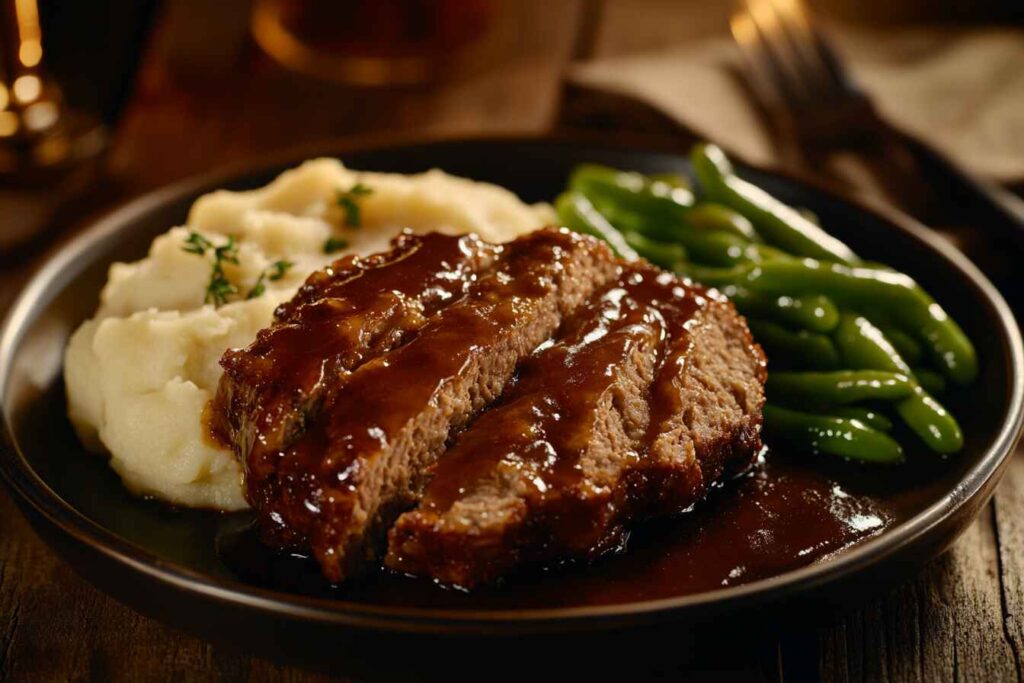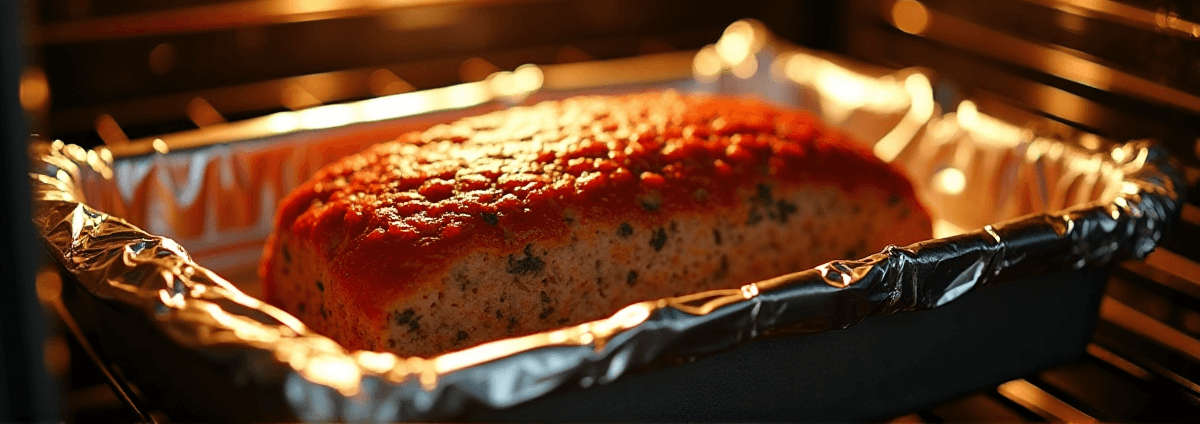Should i cook my meatloaf covered or uncovered ? Meatloaf is a classic comfort food loved for its hearty texture and rich flavors. Whether you’re making it for a family dinner or a holiday gathering, deciding whether to cook meatloaf covered or uncovered is a key factor that can significantly influence the final dish. This seemingly small choice can affect everything from the moisture level to the caramelization of the glaze. If you’re interested in ensuring your meatloaf stays tender, check out Moist Meatloaf Secrets for expert tips.
Covering meatloaf helps lock in moisture, ensuring a tender and juicy texture, while leaving it uncovered allows the glaze to caramelize beautifully, creating a flavorful crust. So, how do you know which method to choose? In this article, we’ll delve into the pros and cons of both techniques, share expert tips, and provide practical advice on achieving the perfect meatloaf every time.
The Basics of Cooking Meatloaf
When cooking meatloaf, the decision to cover or uncover it revolves around two main factors: moisture retention and crust formation. For instance, using innovative binders can help maintain structure. Learn how to use creative alternatives in Use Stove Top Stuffing Instead of Breadcrumbs.
Understanding the Purpose of Covering and Uncovering
When cooking meatloaf, the decision to cover or uncover it revolves around two main factors: moisture retention and crust formation.
- Covering Meatloaf: This method is ideal for preventing the meat from drying out during the cooking process. The cover typically aluminum foil or a lid traps steam, helping the meatloaf retain its natural juices and stay moist.
- Uncovering Meatloaf: Cooking uncovered, on the other hand, allows the heat to directly affect the top layer. This promotes browning, giving the glaze or outer crust a rich, caramelized flavor and a satisfying crunch.
Both methods have their place in crafting a perfect meatloaf, depending on the texture and flavor profile you want to achieve.
The Typical Composition of Meatloaf
A good meatloaf is built on a foundation of ground meat, binders, and seasonings:
- Ground Meat: Common choices include beef, turkey, or a combination.
- Binders: Ingredients like breadcrumbs, oats, or crushed crackers help hold the loaf together. Eggs are often added as a secondary binder.
- Seasonings: Spices, herbs, onions, garlic, and sauces provide depth of flavor.
- Glaze: A topping of ketchup, barbecue sauce, or a sweet-savory mixture adds a finishing touch.
Knowing what goes into your meatloaf helps you decide whether to prioritize moisture or crust in your cooking process.
Baking Temperatures and Times
The standard baking temperature for meatloaf is 350°F (175°C). Cooking times vary based on the size and thickness of the loaf:
- A 2-pound meatloaf typically requires 1 to 1.5 hours.
- A smaller loaf may take around 45 minutes to 1 hour.
Using a meat thermometer is crucial. The ideal internal temperature for a fully cooked meatloaf is 160°F (71°C) for beef and 165°F (74°C) for poultry-based recipes.
Pros of Cooking Meatloaf Covered
One of the biggest challenges in making meatloaf is preventing it from drying out. Covering the meatloaf traps steam, which keeps the meat moist and tender throughout the cooking process. If you’re struggling with structural issues, Keep Meatloaf From Falling Apart provides solutions to common problems.
Moisture Retention: Avoiding a Dry Meatloaf
One of the biggest challenges in making meatloaf is preventing it from drying out. Covering the meatloaf traps steam, which keeps the meat moist and tender throughout the cooking process.
- Steam Locks in Juices: As the meatloaf cooks, its natural juices evaporate. Covering the dish helps retain these juices, ensuring every bite is flavorful and moist.
- Protecting Delicate Ingredients: If your recipe includes ingredients like diced vegetables or breadcrumbs, covering prevents them from drying out or burning before the meatloaf is fully cooked.
Preventing Uneven Cooking
Cooking covered creates a more stable environment inside your oven by distributing heat evenly around the meatloaf. This minimizes the risk of overcooking the outer layers while the center remains undercooked.
- Perfect for Large Loaves: If you’re making a meatloaf that’s thicker or larger than usual, covering it ensures that the heat penetrates the entire loaf evenly.
- Reduces Crust Hardening: For those who prefer a softer exterior, covering prevents the top layer from becoming overly hard or crusty during baking.
Tips for Using Aluminum Foil Effectively
When cooking meatloaf covered, aluminum foil is the most common choice. Here’s how to use it effectively:
- Tent the Foil: Instead of wrapping the meatloaf tightly, tent the foil to allow a small gap for air circulation. This prevents the glaze from sticking to the foil while still trapping enough steam.
- Secure the Edges: Ensure the foil covers the pan completely and seals the edges to prevent steam from escaping.
- Switch to Uncovered Baking at the End: To achieve the best of both worlds, cook the meatloaf covered for most of the baking time, then uncover it during the last 15-20 minutes to caramelize the glaze.
Perfect Recipes for Covered Meatloaf
Certain meatloaf recipes benefit greatly from this method, such as:
- Cheese-Stuffed Meatloaf: The cover prevents the cheese from oozing out prematurely or burning.
- Vegetable-Loaded Meatloaf: Keeps delicate veggies from drying out.
- Poultry-Based Meatloaf: Chicken or turkey meatloaf tends to dry out faster, making the cover essential.
Pros of Cooking Meatloaf Uncovered
Why Cook Meatloaf Uncovered?
Cooking meatloaf uncovered is perfect if you love a crispy crust and caramelized glaze. This method brings out richer flavors and adds texture to your dish, making every bite memorable.
Achieve a Crispy Crust
Cooking meatloaf uncovered lets the outer layer become golden and crispy. The exposed surface reacts to the heat, forming a savory crust. This texture contrast between the crunchy outside and the juicy inside makes your meatloaf irresistible.
Caramelize the Glaze for More Flavor
When the meatloaf is uncovered, the glaze has a chance to caramelize perfectly. Whether you use ketchup, barbecue sauce, or a sweet glaze, the sugars melt and thicken into a delicious topping. This caramelization boosts flavor and gives your meatloaf that classic glossy finish.

Best Times to Cook Uncovered
Uncovering works best during the last 20 to 30 minutes of baking. Start with the meatloaf covered to lock in moisture, then uncover to let the crust and glaze develop. This method ensures both tenderness and flavor.
Ideal Recipes for Uncovered Meatloaf
- Classic Meatloaf with Ketchup Glaze: The top becomes rich and tangy with caramelized ketchup.
- Barbecue Meatloaf: BBQ sauce thickens into a smoky, sticky layer that enhances the dish.
- Mini Meatloafs: Smaller portions cook faster, making it easier to achieve a crispy outer texture.
Cooking meatloaf uncovered gives it a delicious crust and caramelized glaze. To get the perfect balance of tender and crispy, combine covered and uncovered methods during baking.
When to Cover and Uncover Meatloaf
Mastering the balance between covering and uncovering your meatloaf is key to achieving a dish that’s both moist and flavorful. By using a combination of both methods, you can enjoy a tender interior and a perfectly caramelized crust.
Best Practices for Balancing Moisture and Crust
Cooking meatloaf covered for the first part of the baking process ensures that it retains its natural juices. Uncovering it toward the end helps develop a delicious crust and caramelized glaze. Here’s how to strike the perfect balance:
- Cover for Moisture Retention: During the initial baking stage, the foil traps steam, preventing the loaf from drying out. This is particularly important for larger or leaner meatloafs that may take longer to cook.
- Uncover for a Flavorful Finish: Once the meatloaf is nearly done, remove the cover to allow the top layer to brown and the glaze to set. This step adds texture and enhances the flavor.
Timing Recommendations for Uncovering
Knowing when to uncover your meatloaf is crucial. Follow these timing tips:
- Covered Phase: Bake the meatloaf covered for about 75% of the total cooking time. For example, if the recipe calls for a 60-minute bake, keep it covered for the first 45 minutes.
- Uncovered Phase: Remove the cover during the final 15 to 20 minutes. This allows the glaze to caramelize without drying out the meat.
- Adding the Glaze: For the best results, apply the glaze only after uncovering the meatloaf. This prevents the topping from burning during the covered phase.
Balancing Texture and Flavor
Switching between covering and uncovering allows you to create a meatloaf that’s both moist and flavorful. Here are a few additional tips:
- Thickness Matters: Thicker meatloafs may benefit from being covered longer to ensure the heat penetrates evenly.
- Experiment with Timing: If you prefer a slightly softer crust, reduce the uncovered phase by a few minutes. For a crispier finish, uncover earlier or broil briefly at the end.
Practical Tips for Switching Methods
- Foil Placement: If you’re using aluminum foil, tent it slightly over the meatloaf instead of wrapping it tightly. This makes it easier to remove without disturbing the glaze.
- Monitor Closely: Use a meat thermometer to ensure the loaf is fully cooked (160°F for beef, 165°F for poultry) while maintaining its ideal texture.
- Keep the Oven Door Closed: Avoid opening the oven too frequently, as this can disrupt the cooking process and affect the timing.

Tips for Perfect Meatloaf Every Time
A well-cooked meatloaf strikes the perfect balance between tender, moist, and flavorful. By applying a few practical tips and avoiding common mistakes, you can elevate your meatloaf from good to exceptional.
Use a Meat Thermometer for Accuracy
Cooking meatloaf to the correct internal temperature is crucial for food safety and taste. A meat thermometer takes the guesswork out of the process.
- Ideal Temperature: For beef-based meatloaf, the internal temperature should reach 160°F (71°C). For poultry-based versions, aim for 165°F (74°C).
- Placement: Insert the thermometer into the thickest part of the loaf to get an accurate reading. Avoid touching the pan or any fillings like cheese.
- Check Early: Start checking the temperature 10 minutes before the recipe’s suggested time to prevent overcooking.
Rest the Meatloaf Before Slicing
Resting the meatloaf after it’s cooked allows the juices to redistribute, ensuring every slice is moist and flavorful.
- Resting Time: Let the meatloaf sit for 5 to 10 minutes before cutting. Cover it loosely with foil during this period to keep it warm.
- Avoid Early Slicing: Cutting too soon can cause the juices to escape, leading to a drier meatloaf.
Common Mistakes to Avoid
Even seasoned cooks sometimes make errors when preparing meatloaf. Here are some pitfalls to watch out for:
- Skipping the Binder: Always include a binder like breadcrumbs or oats to hold the loaf together and improve texture.
- Overmixing the Meat: Mixing too much can lead to a dense, tough meatloaf. Combine ingredients until just blended.
- Neglecting the Glaze: A glaze adds flavor and enhances the appearance of your meatloaf. Don’t skip this crucial step.
- Ignoring the Pan Choice: Use a shallow baking dish or a meatloaf pan with drainage holes to prevent the loaf from sitting in excess grease.
Experiment with Variations
Meatloaf is highly versatile, so don’t be afraid to customize it to suit your tastes.
- Mix of Meats: Try blending beef, pork, or turkey for a unique flavor profile.
- Herbs and Spices: Add fresh parsley, thyme, or smoked paprika to enhance the taste.
- Fillings: Incorporate cheese, spinach, or boiled eggs for an exciting twist.
- Alternative Glazes: Swap ketchup for honey mustard, sriracha, or a balsamic reduction for a fresh take.
Make-Ahead and Freezing Tips
Meatloaf is a fantastic make-ahead meal that reheats beautifully.
- Prep Ahead: Assemble the meatloaf and store it in the refrigerator for up to 24 hours before baking.
- Freezing: Wrap uncooked meatloaf tightly in plastic wrap and foil. Freeze for up to 3 months. Thaw overnight in the fridge before baking.
- Reheating: To reheat cooked meatloaf, cover it with foil and bake at 325°F (165°C) until warmed through.
Conclusion
Cooking meatloaf covered or uncovered depends on your personal preference for moisture or texture. For a tender, juicy loaf, covering it during the early stages is the way to go. To achieve a flavorful crust and caramelized glaze, uncover the meatloaf during the final minutes. By combining these methods and following our tips, you can create a perfectly balanced, delicious meatloaf every time.

